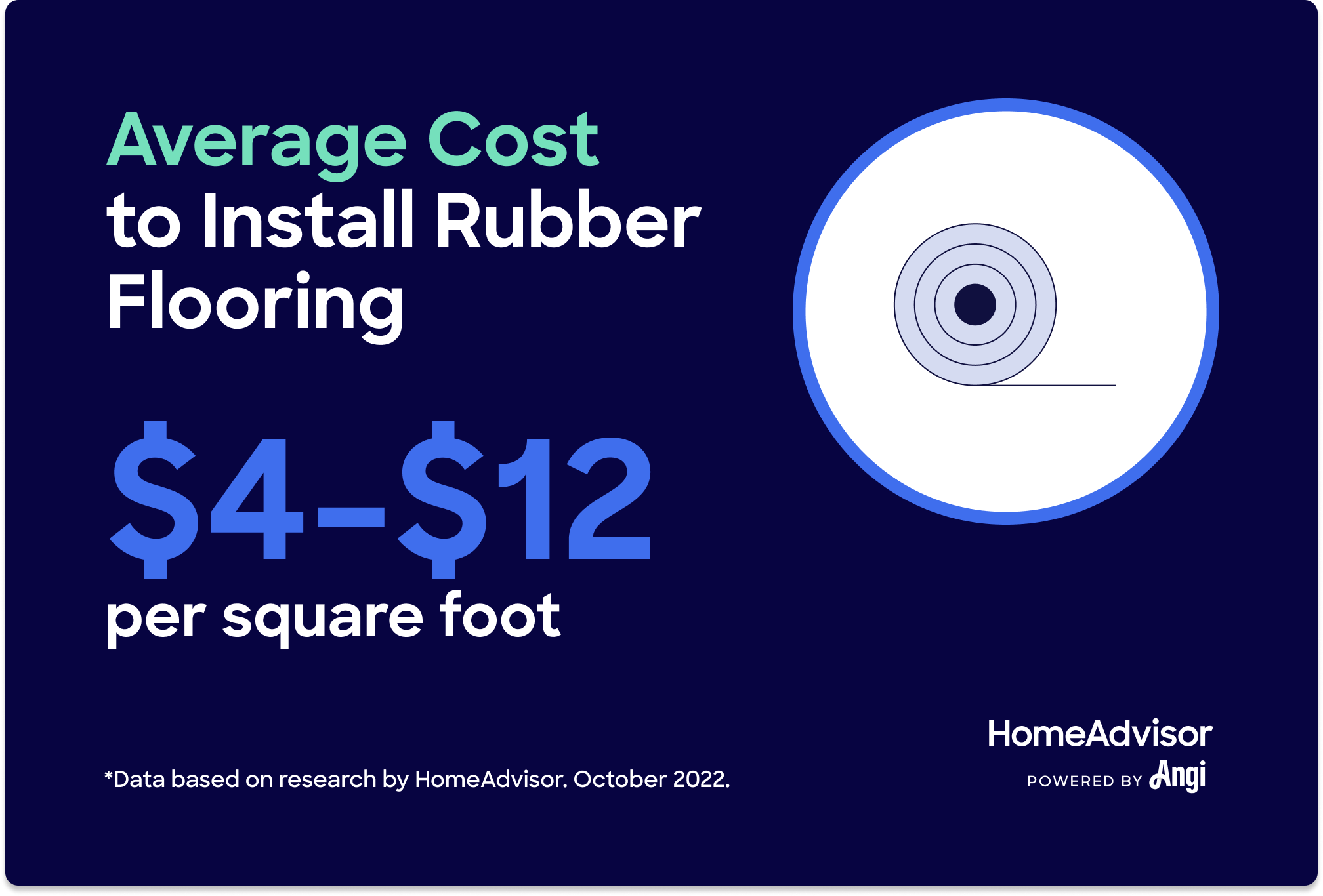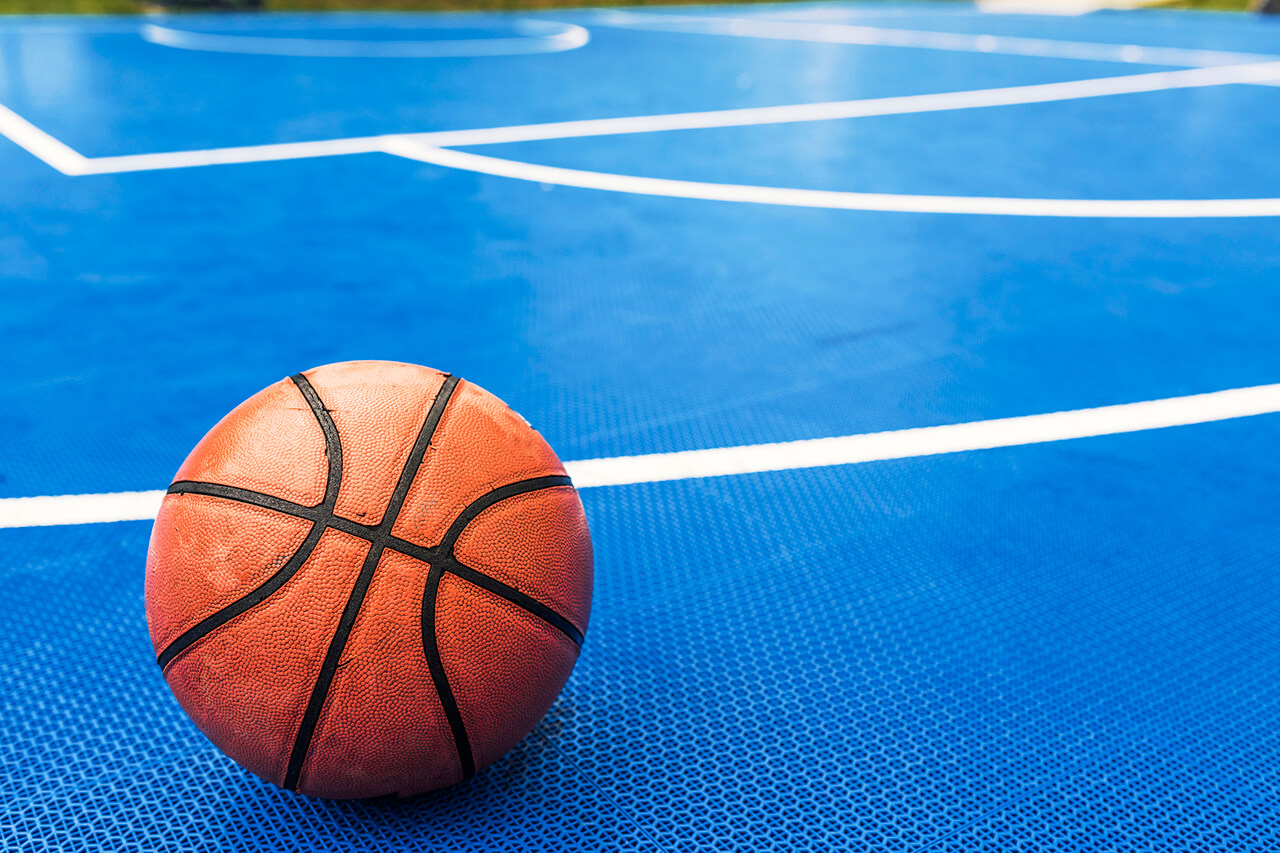How Much Does Rubber Flooring Cost?
Typical Range:
$800 - $2,300
Typical Range:
$800 - $2,300
Cost data is based on research by HomeAdvisor.
Updated April 18, 2024
Written by HomeAdvisor.Hiring a pro for rubber flooring installation ensures accurate measuring, cutting, mixing, and warranty maintenance.
The average price to install rubber tile flooring is $720, while poured-in-place flooring costs about $2,300.
The cost of rubber flooring depends on material type, installation complexity, subfloor condition, and geographical location.
Popular materials for rubber flooring include tiles, poured floor coating, rolled mats, and rubberized wood.
Rubber flooring is durable, water-resistant, absorbs impact, easy to maintain, and install.
Highlights were summarized from this existing cost guide text using automation technology and were thoroughly reviewed for accuracy by HomeAdvisor Editor Ryan Noonan.
Rubber tile flooring averages $10 per square foot total, or about $2 per square foot for installation alone. Tiling projects typically fall between $800 and $1,500 for a 144-square-foot room. Poured-in-place rubber flooring is about $16 per square foot or $2,300 total for a standard-size room.
Rubber flooring prices are highly variable, changing based on thickness, material quality, room size, subfloor state, and installation area. The material alone usually costs between $3 and $8 per square foot, but luxury tile or thick-poured rubber can be more. This is comparable to other home flooring materials, like hardwood and tile.
Labor fees vary for this project. Expect to pay an extra $1 to $4 per square foot for professional installation, or between $16 and $100 per hour.
| Average Cost | High Cost | Low Cost |
|---|---|---|
| $10 per square foot | $12 per square foot | $4 per square foot |
The cost of rubber flooring is between $1 and $16 per square foot. Poured rubber surfaces are the most expensive, while tiles and rolled mats are the least expensive. However, tiles can be more expensive if you opt for a high-end look.
| Rubber Floor Type | Average Cost Range per Sq. Ft. for Material |
|---|---|
| Tiles | $3 – $8 |
| Poured-in-place | $9 – $16 |
| Rolled mat | $1 – $5 |
| Rubberized wood | $1 – $5 |
| Nora | Varies |
Rubber tiles run between $3 and $8 per square foot. Ballistic rubber tile prices land at the top of this range, while thinner ones are less expensive.
These are great options for those installing rubber flooring in a smaller room. The squares are easier to install and only take a day or two if done by a professional, assuming your subfloor is in good shape.
Poured floor coating is the most expensive, with materials between $9 and $16 per square foot. High-end options can run up to $20 per square foot. Installation adds around $3 per square foot to your overall estimate. Unless you’re highly experienced, it’s best to hire a pro for the project.
For outside surfaces, the cost to install poured-in-place rubber flooring is similar.
Rolled mats are the least expensive option for materials at $1 to $5 per square foot. These are easier to install than poured floor coating, so labor costs are lower.
Mats are good for those who plan to add significant weight to their rubber floors. They’re more likely to hold up to a beating than tiles that can break apart, suitable for a home gym or children’s playroom.
Wood-like vinyl, PVC, and foam flooring tiles run between $1 and $5 per square foot and are typically better options than rubber when seeking a wooden look. You can print wood patterns onto these materials while getting traction and cushioning similar to rubber.
However, rubber wood-like flooring is hard to come by, and the closest you can get is a material that mimics the color of wood.
Nora is a popular brand that offers rolled mat and tile flooring options for various prices. You can purchase from this brand for residential use through a local flooring dealer, and Nora flooring requires professional installation. Some of their product warranties last up to 10 years, so they’re frequently used in hospitals, schools, and other public buildings.
The average price to install rubber tile flooring is $720 for a standard 144-square-foot room. Poured-in-place flooring costs about $2,300 to lay, comparable to the average $2,900 cost to install flooring from other popular materials like wood and laminate.
Factors that influence labor fees include the following:
Corners: More corners mean more work and higher costs
Room size: Smaller spaces cost more per square foot
Subflooring installation cost: $30–$35 per sq. ft. in addition to the price of rubber
Location: Expect to pay more if you live in an area with a higher cost of living
Number of workers: Fewer workers means lower cost
Stairs: Installing on steps increases the price
Rubber flooring is a popular option for many kitchens, particularly if you spend a lot of time on your feet. The soft surface is easier on your knees and back and makes standing more comfortable. And if you happen to drop a bowl, this option is shatter-resistant.
They work well in bathrooms since they’re slip- and water-resistant. The steam and dampness from showers shouldn’t bother the material.
At $16 per square foot, poured rubber is an excellent option to go under cars since tile options can break up easily. Rolled mats and tiles cost half as much and work well for garage gyms or tool bench areas. But remember that petroleum from cars could break down these surfaces over time. We discuss rubber flooring for home gyms in the next section.
It costs about $1,000 to replace rubber floor tiles in a 144-square-foot room. To switch out a poured surface, expect to pay around $3,200. This project will take longer than a basic installation, so prepare to pay more for labor.
On average, rubber tile flooring is $1,000 when installed in a 144-square-foot gym. Rolled mats cost slightly less at around $720. The thicker the material, the more weight it can withstand, but thicker material is more expensive. Mats and tiles are the most cost-effective options since home gyms tend to be smaller and not worth the cost of poured-in-place surfacing.
Benefits of rubber gym flooring include the following:
Damage-resistance for heavy weights
Water- and sweat-resistant
Great traction for quick movements
Other ideas for gym flooring include the following:
Cushioned vinyl flooring: Frequently used for basketball courts, it absorbs high-impact activities like jumping. Installing an indoor basketball court starts at $16,000.
Gym turf: Like artificial grass on football fields, this material is good for resistance training. Turf costs around $2–$3 per sq. ft.
Foam tiles: Less expensive than other gym floorings, foam is great for yoga and stretching exercises. They're generally priced at less than $2 per sq. ft.
Rubber floors have many advantages and some disadvantages. Take a look at the list below to determine whether they’re suitable for your home and needs.
Advantages:
Easy to maintain
Flexible
Durable
Water-resistant
Noise-resistant
Can absorb impact
Easy to install
Disadvantages:
Fewer style choices than other floor options
Rubbery smell
Slippery when wet
Can lack visual appeal for areas such as living or entertainment rooms
You have numerous flooring options for your home. Compare them to rubber floors before you commit to one, or mix and match different flooring materials depending on the room type and your personal preferences.
Vinyl flooring cost: Like rubber floors, they’re budget-friendly, easy to maintain, water-resistant, and durable. Another benefit to vinyl floors is that there are more style and color options to choose from, like the cost of LVT floors.
Carpet cost: Like rubber floors, carpet can also help provide insulation from the cold and sound and is less expensive than the cost of hardwood floors. But carpets have more style varieties and can help your space look cozy and inviting compared to rubber flooring.
Cork flooring cost: Like rubber floors, they're heat-insulating and sound-dampening. They're also easy to install, often using a snap-and-lock process to fit together. But a major con is that cork floors require regular maintenance and must be resealed every few years.
A pro can add anywhere from $1 to $4 per square foot in installation fees, excluding the cost of materials. Choosing to DIY versus hiring a local flooring contractor can be difficult. Poured rubber surfacing and rolled mats usually require a contractor’s help, as there’s a lot of measuring, cutting, and mixing involved.
Also, some flooring brands require professional installation to maintain their warranties. You may choose to install tiles on your own, but a pro is the way to go for a larger space with more complicated corners.
Rubberized flooring offers many advantages, particularly for homes with children, those who enjoy exercising, and people with physical disabilities. Some of the benefits include the following:
Slip-resistant
Water-resistant
Can absorb large impacts
Retains shape
Offers great traction
Better accessibility for people with disabilities
Thicker material for a higher fall rating
Quick installation
At approximately $1 to $5 per square foot, rolled mats are the least expensive flooring option since they cover a large surface area and are a better long-term option than tile. Rubber tile is the next inexpensive option at around $3 and $8 per square foot, with poured surfacing costing the most.
Rubber tiles typically take less than two days to install. However, this depends on the state of your floors and the room shape. Since the tiles can snap together, the longest part of the process is cutting and measuring the material to make it fit the room. However, expect the project to take longer if your subfloor is in bad condition. The cost to repair your subfloor averages $560.
Recycled tire flooring averages $11 per square foot, or about $5 less than poured flooring. However, recycled material loses its color faster and requires more frequent resurfacing every five years, so it may not be as cost-effective in the long run.

